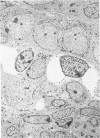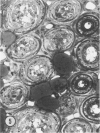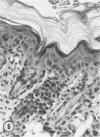Abstract
Pellagra in the human is characterized by the clinical "three D's," namely, dermatitis, diarrhea, and dementia. Newborn mice that received a single intraperitoneal injection of 6-aminonicotinamide (6-AN) (50 mg/kg body weight), an antagonist of niacin, consistently developed lesions in the skin, intestinal tract, and central nervous system. Anterior horn cells in the spinal cord as well as motor neurons in the brain showed the ultrastructural features of neuronal chromatolysis, while glial and ependymal cells showed postinjection (PI) edematous changes on Day 5. In the skin, correlating with clinical delay of hair growth, the first discernible microscopic abnormality was vacuolar change in the hair follicles on PI Day 3. By PI Day 5, hyperkeratosis and irregular acanthosis were noted. Edematous swelling of the enteric glial cells was observed in the myenteric plexus of the descending colon on PI Day 5. Although the pathologic features of these 6-AN-treated mice may not be exactly identical to those of human pellagra, possible contributory mechanisms in the development of pellagra lesions may be elucidated by this experimental model.
Full text
PDF

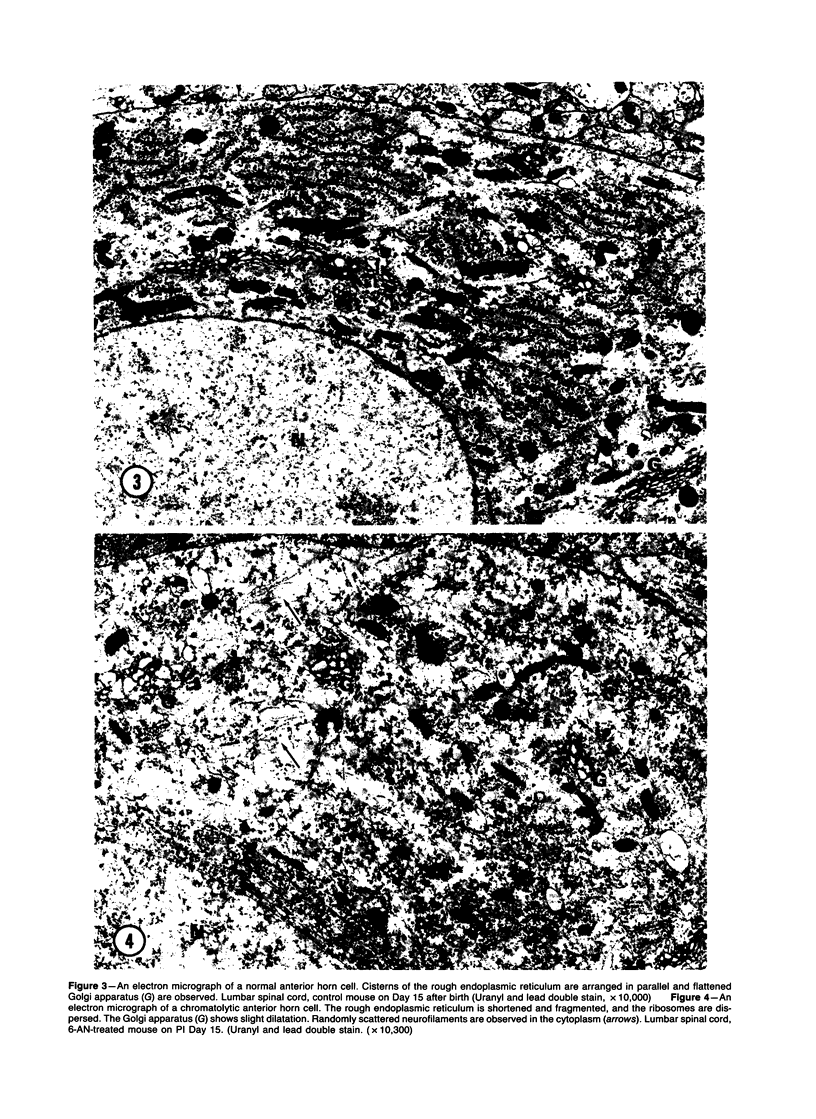

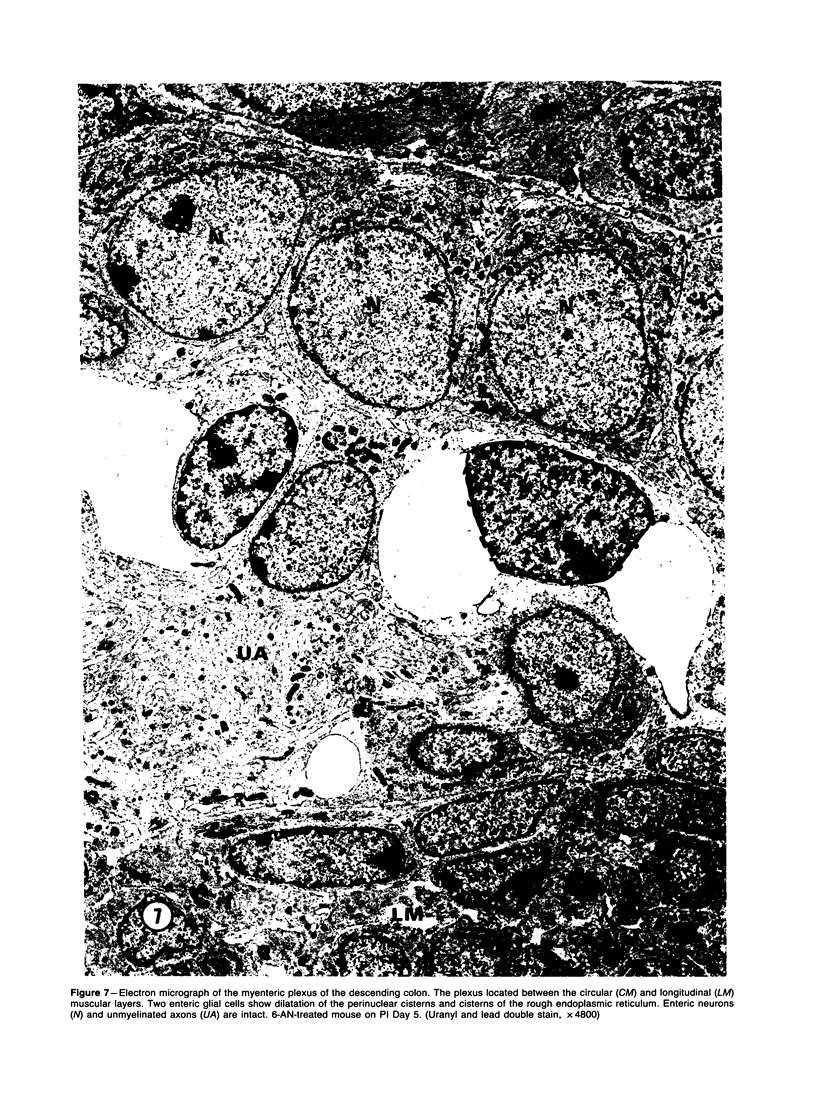
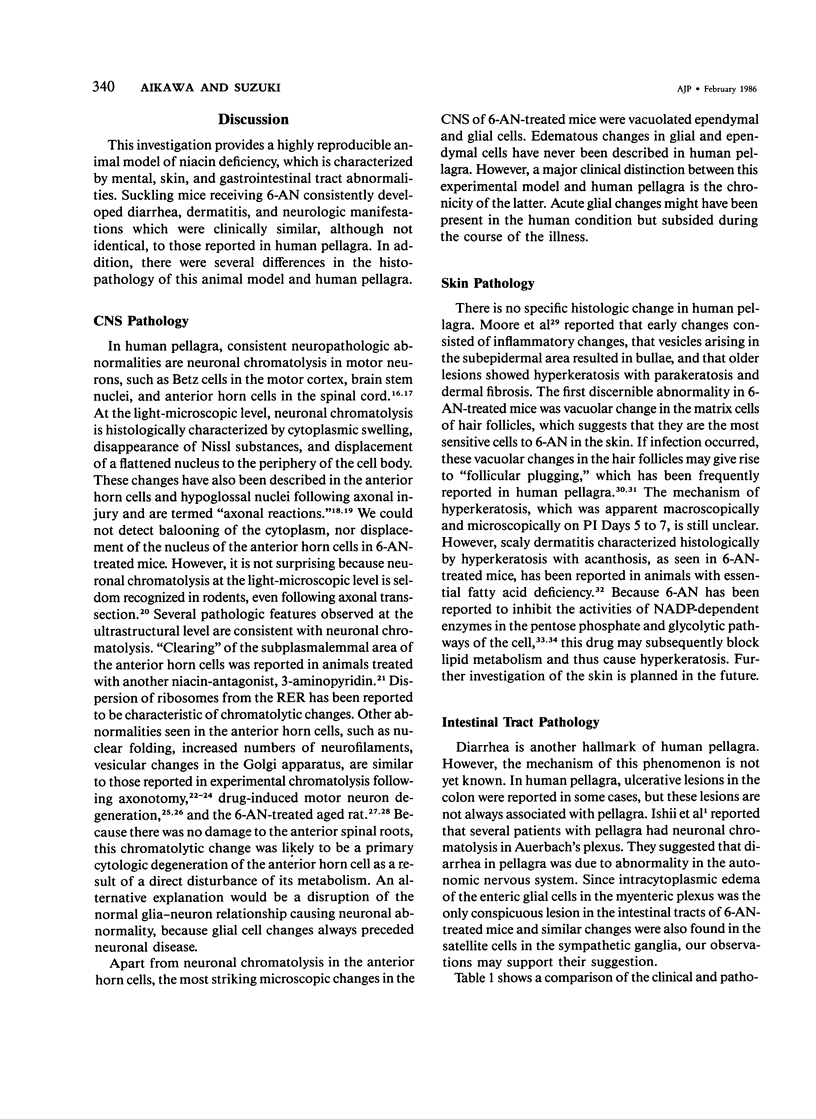
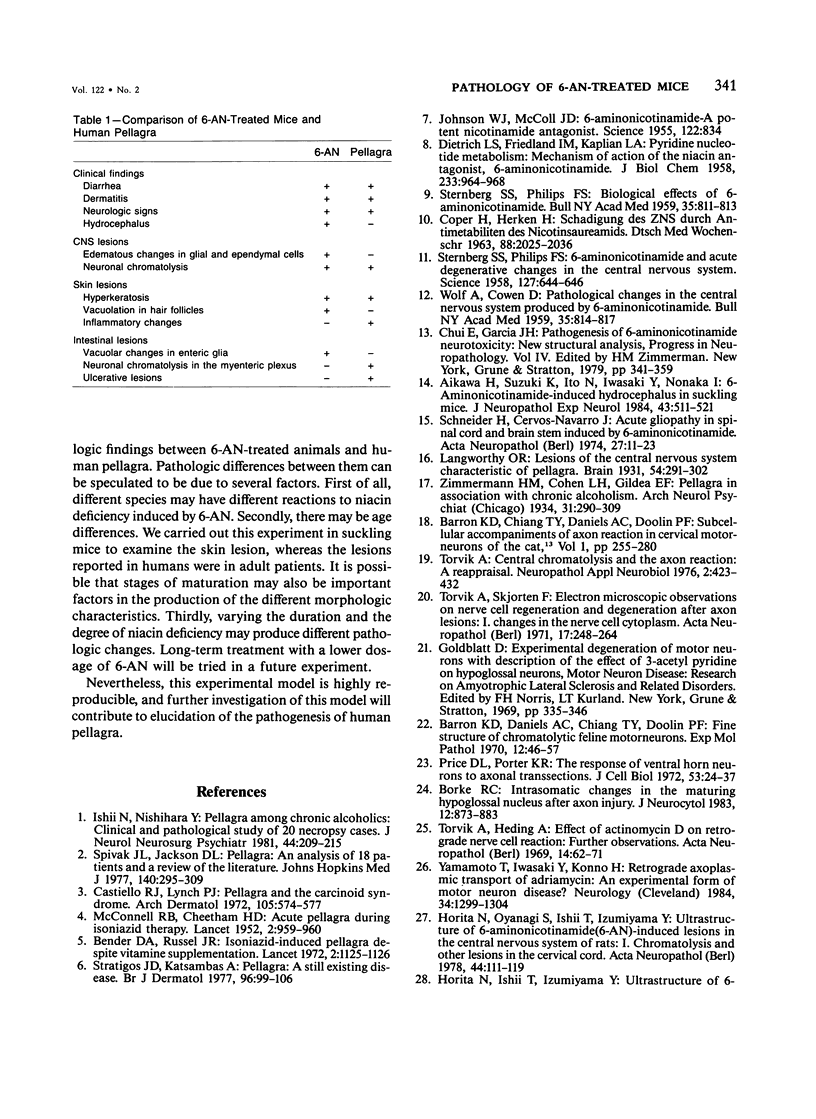

Images in this article
Selected References
These references are in PubMed. This may not be the complete list of references from this article.
- Aikawa H., Suzuki K., Ito N., Iwasaki Y., Nonaka I. 6-Aminonicotinamide-induced hydrocephalus in suckling mice. J Neuropathol Exp Neurol. 1984 Sep;43(5):511–521. doi: 10.1097/00005072-198409000-00006. [DOI] [PubMed] [Google Scholar]
- Barron K. D., Daniels A. C., Chiang T. Y., Doolin P. F. Fine structure of chromatolytic feline motoneurons. Exp Mol Pathol. 1970 Feb;12(1):46–57. doi: 10.1016/0014-4800(70)90074-2. [DOI] [PubMed] [Google Scholar]
- Bender D. A., Russell-Jones R. Isoniazid-induced pellagra despite vitamin-B6 supplementation. Lancet. 1979 Nov 24;2(8152):1125–1126. doi: 10.1016/s0140-6736(79)92519-4. [DOI] [PubMed] [Google Scholar]
- Borke R. C. Intrasomatic changes in the maturing hypoglossal nucleus after axon injury. J Neurocytol. 1983 Oct;12(5):873–883. doi: 10.1007/BF01258157. [DOI] [PubMed] [Google Scholar]
- COPER H., HERKEN H. SCHAEDIGUNG DES ZENTRALNERVENSYSTEMS DURCH ANTIMETABOLITEN DES NIKOTINSAEUREAMIDS. EIN BEITRAG ZUR MOLEKULARPATHOLOGIE DER PYRIDINUKLEOTIDE. Dtsch Med Wochenschr. 1963 Oct 18;88:2025–2036. doi: 10.1055/s-0028-1112326. [DOI] [PubMed] [Google Scholar]
- Castiello R. J., Lynch P. J. Pellagra and the carcinoid syndrome. Arch Dermatol. 1972 Apr;105(4):574–577. [PubMed] [Google Scholar]
- Cohen L. K., George W., Smith R. Isoniazid-induced acne and pellagra. Occurrence in slow inactivators of isoniazid. Arch Dermatol. 1974 Mar;109(3):377–381. [PubMed] [Google Scholar]
- DIETRICH L. S., FRIEDLAND I. M., KAPLAN L. A. Pyridine nucleotide metabolism: mechanism of action of the niacin antagonist, 6-aminonicotinamide. J Biol Chem. 1958 Oct;233(4):964–968. [PubMed] [Google Scholar]
- Horita N., Ishii T., Izumiyama Y. Ultrastructure of 6-aminonicotinamide (6-AN)-induced lesions in the central nervous system of rats. III. Alterations of the spinal gray matter lesion with aging. Acta Neuropathol. 1981;53(3):227–235. doi: 10.1007/BF00688026. [DOI] [PubMed] [Google Scholar]
- Horita N., Oyanagi S., Ishii T., Izumiyama Y. Ultrastructure of 6-aminonicotinamide (6-an)--induced lesions in the central nervous system of rats. Acta Neuropathol. 1978 Nov 15;44(2):111–119. doi: 10.1007/BF00691476. [DOI] [PubMed] [Google Scholar]
- Ishii N., Nishihara Y. Pellagra among chronic alcoholics: clinical and pathological study of 20 necropsy cases. J Neurol Neurosurg Psychiatry. 1981 Mar;44(3):209–215. doi: 10.1136/jnnp.44.3.209. [DOI] [PMC free article] [PubMed] [Google Scholar]
- Johnson W. J., McColl J. D. 6-Aminonicotinamide--a Potent Nicotinamide Antagonist. Science. 1955 Oct 28;122(3174):834–834. doi: 10.1126/science.122.3174.834. [DOI] [PubMed] [Google Scholar]
- Kauffman F. C., Johnson E. C. Cerebral energy reserves and glycolysis in neural tissue of 6-aminonicotinamide-treated mice. J Neurobiol. 1974;5(5):379–392. doi: 10.1002/neu.480050502. [DOI] [PubMed] [Google Scholar]
- MCCONNELL R. B., CHEETHAM H. D. Acute pellagra during isoniazid therapy. Lancet. 1952 Nov 15;2(6742):959–960. doi: 10.1016/s0140-6736(52)92202-2. [DOI] [PubMed] [Google Scholar]
- McCullough J. L., Schreiber S. H., Ziboh V. A. Cell proliferation kinetics of epidermis in the essential fatty acid deficient rat. J Invest Dermatol. 1978 Jun;70(6):318–320. doi: 10.1111/1523-1747.ep12543484. [DOI] [PubMed] [Google Scholar]
- Price D. L., Porter K. R. The response of ventral horn neurons to axonal transection. J Cell Biol. 1972 Apr;53(1):24–37. doi: 10.1083/jcb.53.1.24. [DOI] [PMC free article] [PubMed] [Google Scholar]
- STERNBERG S. S., PHILIPS F. S. 6-Aminonicotinamide and acute degenerative changes in the central nervous system. Science. 1958 Mar 21;127(3299):644–646. doi: 10.1126/science.127.3299.644-a. [DOI] [PubMed] [Google Scholar]
- STERNBERG S. S., PHILIPS F. S. Biological effects of 6-aminonicotinamide. Bull N Y Acad Med. 1959 Dec;35:811–813. [PubMed] [Google Scholar]
- Schneider H., Cervos-Navarro J. Acute gliopathy in spinal cord and brain stem induced by 6-aminonicotinamide. Acta Neuropathol. 1974 Feb 7;27(1):11–23. doi: 10.1007/BF00687236. [DOI] [PubMed] [Google Scholar]
- Spivak J. L., Jackson D. L. Pellagra: an analysis of 18 patients and a review of the literature. Johns Hopkins Med J. 1977 Jun;140(6):295–309. [PubMed] [Google Scholar]
- Stratigos J. D., Katsambas A. Pellagra: a still existing disease. Br J Dermatol. 1977 Jan;96(1):99–106. doi: 10.1111/j.1365-2133.1977.tb05197.x. [DOI] [PubMed] [Google Scholar]
- Torvik A., Heding A. Effect of actinomycin D on retrograde nerve cell reaction. Further observations. Acta Neuropathol. 1969 Sep 9;14(1):62–71. doi: 10.1007/BF00687703. [DOI] [PubMed] [Google Scholar]
- Torvik A., Skjörten F. Electron microscopic observations on nerve cell regeneration and degeneration after axon lesions. I. Changes in the nerve cell cytoplasm. Acta Neuropathol. 1971;17(3):248–264. doi: 10.1007/BF00685058. [DOI] [PubMed] [Google Scholar]
- WOLF A., COWEN D. Pathological changes in the central nervous system produced by 6-aminonicotinamide. Bull N Y Acad Med. 1959 Dec;35:814–817. [PMC free article] [PubMed] [Google Scholar]
- Yamamoto T., Iwasaki Y., Konno H. Retrograde axoplasmic transport of adriamycin: an experimental form of motor neuron disease? Neurology. 1984 Oct;34(10):1299–1304. doi: 10.1212/wnl.34.10.1299. [DOI] [PubMed] [Google Scholar]





